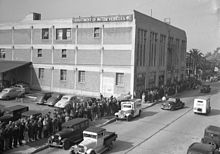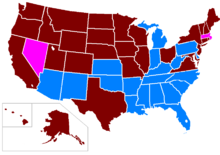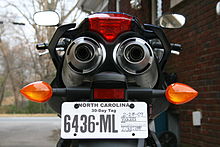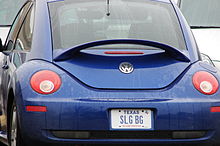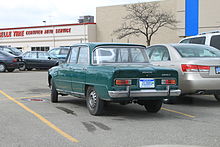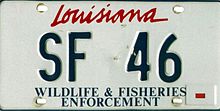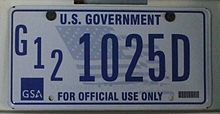- Vehicle registration plates of the United States
-
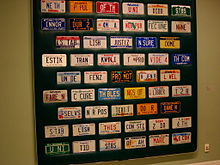 License plates of the 50 U.S. states and the District of Columbia phonetically spelling the Preamble to the United States Constitution, displayed in the Smithsonian Institution.
License plates of the 50 U.S. states and the District of Columbia phonetically spelling the Preamble to the United States Constitution, displayed in the Smithsonian Institution.
In the United States, license plates[1] are issued by an agency of the state or territorial government, and in the case of the District of Columbia the District government. Some Native American tribes also issue plates. The U.S. federal government issues plates only for its own vehicle fleet and for vehicles owned by foreign diplomats. Until the 1980s, diplomatic plates were issued by the state in which the consulate or embassy was located.
The appearances of plates are frequently chosen to contain symbols, colors, or slogans associated with the issuing jurisdiction.
The term license plate is frequently used in statute, although in some areas tags is informally used. The term tag stems from small stickers issued periodically to indicate that the vehicle registration is current, rather than replacing the entire license plate each year.[citation needed]
Designs and serial formats
Main article: United States license plate designs and serial formatsThe appearances of plates are frequently chosen to contain symbols, colors, or slogans associated with the issuing jurisdiction. Formats for license plate numbers, which are usually alphanumeric, are designed to provide enough unique numbers for all motor vehicles a jurisdiction expects to register. For example, the small states Delaware and Rhode Island are able to use formats of 123456 and 123-456, respectively, while California uses the seven-character format 1ABC234, and several other populous states and provinces use a seven-character ABC1234 format. Other formats include those that utilize a county-coding system or month of expiration is incorporated into the plate number as in Massachusetts, which uses the last digit, and West Virginia, which uses the first digit, which can be from 1-9 or O (October), N or D.
In 2010, New Jersey switched from their old ABC-12D format to the current A12-BCD format when they ran out of numbers. Their current format, for example, would run from A00-AAA to Z99-AAA, then would progress to A00-AAB.[2]
Maryland, which used to have a 1AB-C23 format on their license plates, now has a 1 A/A 0000 format. The District of Columbia changed a few years ago from a 123-456 format to an AB1234 format.
Non-passenger vehicles tend to have their own special format and often have the vehicle type listed on the plate.
In the United States, many states and provinces distinguish their license plates through distinctive color schemes and logos, which historically have been changed annually. For example, the cowboy logo often associated with the state of Wyoming has appeared on that state's license plates continuously since 1936. Some early Tennessee plates were produced in a parallelogram shape approximating that of the state.
Vermont license plates have frequently featured a green and white color scheme, while Alaska and New York has preferred yellow and blue. California, Maryland, Massachusetts, Michigan, Virginia, and Wisconsin all have plain white license plates with little decoration.
Florida, Georgia, Indiana, Maryland, Michigan, Nebraska, Pennsylvania, South Carolina,[3] West Virginia, and Washington, D.C. have placed the address of the state's official or tourism web site on their general issue plates. Most plates in Washington, D.C. contain the phrase "Taxation without representation" to highlight the District's lack of a voting representative in the United States Congress.
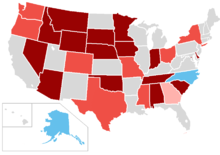
 Issues only embossed plates.Issues only flat-screened plates.Issues embossed standard-issue plates and flat-screened personalized plates and optional types and, in some states, non-passenger types.Mostly issues embossed plates but issues one type of flat-screened optional plate.Previously issued flat-screened plates but subsequently reverted to embossed plates.
Issues only embossed plates.Issues only flat-screened plates.Issues embossed standard-issue plates and flat-screened personalized plates and optional types and, in some states, non-passenger types.Mostly issues embossed plates but issues one type of flat-screened optional plate.Previously issued flat-screened plates but subsequently reverted to embossed plates.Typically, the registration number is embossed — or, more rarely, impressed — onto the license plate. Other identifying information, such as the name of the issuing jurisdiction and the vehicle class, can be either surface-printed or embossed; Virginia, for example, does the former for passenger cars and the latter for most non-passenger vehicles. However, it is increasingly common in the U.S. for the registration number to be surface-printed using digital printing technology. Colorado, Mississippi, Missouri, New York, North Carolina, Ohio, Oregon, Texas, and Washington do so only for certain types of license plates, such as vanity plates and special issues; Alabama, Arizona, Indiana, Iowa, Minnesota, Montana, Nebraska, Nevada, South Carolina, South Dakota, Tennessee, Wyoming, and the District of Columbia have switched to the so-called "flat plate" technology for all their license plates. Delaware license plates have not been embossed for several decades. License plates originally were not embossed, but were merely flat plates in various forms, typically rectangular. It was found by the 1930s that they could be easily forged, and subsequently plates were embossed as the equipment to do this was not easily available to criminals wishing to create their own plates.
In 1956, the U.S. and Canadian federal governments came to an agreement with the Automobile Manufacturers Association that fixed the size for all their passenger vehicle plates at six inches in height by twelve inches in width, although these figures may vary slightly by jurisdiction.[citation needed] In North America, only Saint Pierre and Miquelon has not adopted these standards.[citation needed] (Although the Northwest Territories and Nunavut plates are cut in the shape of a polar bear, their overall size and mounting holes are compatible with those of the rest of Canada and the U.S.) Smaller-sized plates are used for motorcycles and, in some jurisdictions, mopeds and certain types of trailers and construction equipment.[4]
Showing current registration on plates
Historically, many U.S. and Canadian plates were replaced every year, although the most common practice in modern times is to send new validation or windshield stickers to vehicle owners every year or two, to indicate that the vehicle registration is still valid.
Tags that are not up to date quickly attract the attention of law enforcement, because registration "renewal" is a source of government revenue. Even with the tags, most states previously required that all license plates be replaced every few years; that practice is being abandoned by many states because of the expense of continually producing large numbers of plates. Maryland, for example, formerly mandated that all license plates be replaced every five years (except for apportioned trailers, which were registered on an eight-year schedule), but has not done so since 1986.
The sticker is usually placed on one corner of the plate, while the month of the year in which the plate would expire is printed in an opposing corner. Some jurisdictions combine the year and month on one sticker. In others, the plate's validation is a decal displayed from the inside of the windshield. The color of plate stickers and windshield decals often change annually, to allow for easier detection by police.
Most validation stickers are either serialized (with the serial number recorded on the registration), or are printed by a special printer at the time of registration or renewal with the vehicle's license plate number on them to discourage fraudulent sticker use, as the sticker will be valid only for the plate for which it was intended. In the District of Columbia, the license plate is validated with a windshield sticker that indicates the expiration date, the license plate number, the year and make of vehicle, and part of the vehicle identification number, thereby allowing easier detection of fraudulent use, as well as serving as a parking permit for neighborhood residents.
New York, Texas, and Washington, D.C. use windshield stickers exclusively, rather than plate stickers, for most vehicle classes. Connecticut switched to this method in September 2008, but subsequently revoked the requirement for windshield stickers effective August 2010. New Jersey required the use of plate decals for a few years, beginning with November 2000 expirations, but has not required them on passenger cars since October 1, 2004. New Jersey passenger vehicles do not display any registration information other than the license plate itself.
Pennsylvania issued validation stickers for Philadelphia residents that were displayed in the lower left corner of cars' rear windows for a few years, ending in late 2003 with the last stickers issued bearing January 2005 expirations, due to problems with theft of stickers attached to the license plate.
In Hawaii, the case of vehicle registration dues are a heated debate between the counties. Vehicles are purchased at a discount on Oʻahu compared to the neighboring islands where there is usually only one dealer per vehicle make. Because the outlying counties issue plates starting with M (Maui County), K (Kauaʻi), or H (Big Island of Hawaiʻi), the source of the vehicle can be identified.
Life cycle
When a person moves to a new state, he or she is required to establish residency in the new state. The laws of the state will dictate the requirements for establishing residency and vehicle registration. The state will then issue a new plate or plates that must be attached to the vehicle. One prominent exception is active duty military service members; under federal law, they do not change their legal residence when they move to a new posting and are not obliged to re-register their vehicle with the state in which they are newly assigned. Students attending school in a state other than their own are also typically exempt from transferring their registration, although a few states consider all students to be residents for purposes of vehicle registration, insurance, and driver's licensing.[citation needed] A few other states, such as New York, allow, although do not require, out of state students to register their vehicles in state.[citation needed] Hawaii requires all persons moving to the state to register their vehicle to Hawaii. However, if your vehicle is still registered, you may keep those plates until they expire, but you have to get an out of state plate permit.
When a vehicle is sold, the disposition of the license plates depends on state law and varies by state. In some states, license plates are transferred with the vehicle to its new owner. In other states, the license plates remain with the seller, who may, for a fee, transfer the license plates and any unused portion of the current registration to a new vehicle. Some states issue a new plate whenever the car is sold.
The various states have different schemes for reissuing license plates, a process known as "replating". In some jurisdictions, plates are issued on a permanent basis and are not replaced unless the owner requests a new plate or that his or her existing plate be remade, or the plate becomes illegible. These jurisdictions include California, Delaware, Massachusetts,[5] Oklahoma, and Oregon. Other jurisdictions replate on a rolling basis, replacing a particular motorist's plate when it reaches a certain age. Jurisdictions employing a rolling replate program include Arkansas (plates reissued every eight years), Florida (ten years), Idaho (seven years), Minnesota (seven years), Texas (seven years), and Washington (seven years due to the five-year warranty on the reflective coating). Due to the Great Recession, Pennsylvania repealed its 1999 legislation in 2008 which required a replate every ten years, just in time to avoid the replate which would have been mandated by law for 2009.
Yet other jurisdictions may recall a particular series of plates for reissuance at regular or irregular intervals. This is particularly common in jurisdictions in which only one license plate series or design is valid at any given time. Optional-issue plates may or may not follow the same rules for replacement as standard-issue plates, depending on the jurisdiction.
New York usually replaces plates every 15 years. However, in 2009, due to the state's fiscal crisis, Gov. David Paterson decided to replace every plate in the state, with the oldest being 8 years. The mandatory plate replacement was rescinded in February 2010, but license plate fees were increased instead.
Mississippi replates every 5 years with the new plates to replace the old ones beginning in October.
Front/rear mounting
Many American states are now strictly enforcing laws that require vehicles to display two license plates (on the rear and front of the vehicle).[6] One possible benefit of front license plates is to increase the effectiveness of red-light cameras, which only work if a vehicle can be linked back to its registered owner. Another benefit is to aid in laser speed enforcement activity, whereby a police officer aims a laser speed measuring device at the highly reflective surface of a front license plate. Opponents of two license plates usually do not like front plates on certain sports cars and historic cars because of their visual obtrusiveness from the vehicle. They argue that they add cost to production, use resources (metal), create double the amount of waste and do not give police any extra tool in recovering stolen vehicles.[citation needed]
California is one of an increasing number of states whose law requiring a front license plate on all vehicles is being petitioned. The petitions are traditionally the result of effort put forth by motorists and car auto enthusiasts who prefer the clean, unobstructed viewing of the front fascia and grille of their vehicle and see little or no practicality in having a front plate on display. Some argue that the presence of a front license plate means unnecessary damage when mounting hardware comes into contact with the bumper of another vehicle. Others argue about whether or not the U.S. front plate interferes with the vehicle's cooling system when mounted in the traditional location (versus, for example, a slimmer European plate). Some also feel the placement of the front plate interferes with a vehicle's aerodynamics; creating more cabin noise by the increased drag, as well as contributing to reduced fuel mileage. Variations on placement include displaying the front plate inside the vehicle between the dashboard and front windshield, having both a state-issued and vanity plate insert on display, and having only a vanity plate insert on display. Police officers frequently cite motorists whose vehicles do not comply with California Vehicle Code section 5200, giving the offender the opportunity to correct the offense.[citation needed]
The petition originally drafted by William Shaw, argues that not having a front plate on display does not interfere with law enforcement and states:
- "Law enforcement officials might be opposed to a measure abolishing the front license plate requirement, because they might believe that losing the extra plate will make it more difficult for them to do their jobs in the best possible manner. However, in the 20 or more states that have abolished the front license plate requirement, there is no evidence of a decline in public safety as a result of the plate removal."[7]
In the U.S., the states of Alabama, Arizona, Arkansas, Delaware, Florida, Georgia, Indiana, Kansas, Kentucky, Louisiana, Michigan, Mississippi, New Mexico, North Carolina, Oklahoma, Pennsylvania, South Carolina, Tennessee, and West Virginia require license plates only on the rear of the vehicle. Some vanity and specialty plates in Arizona are issued in pairs, but only the rear plate is required to be displayed; the optional front plate is something of a bonus for paying an extra fee for the plate.[8]
Kansas used to issue just personalized plates in pairs with the front being optional (K.S.A. 8-132), but as of the 2011-2015 series, only the rear plate will be issued. Further, Kansas has long prohibited front plates, including old/expired personalized plates, except for model year plates on antiques, tractor-trucks (semis), and until recently current and matching personalized plates per K.S.A. 8-133 and the KDOR.[9]
Nevada's policy on front license plate display is dependent on the design of the car. The DMV issues two plates for cars but the display of the front plate is optional only if the vehicle was not designed for a front plate and the manufacturer did not provide an add-on bracket or other means of displaying the front plate. However, if the second plate is not displayed, it is the owner's responsibility to store the second plate and surrender or return both plates to the department at the appropriate time.[10]
Massachusetts is a unique case for license plate mounting. Before the introduction of the current "Spirit of America" base starting in 1986 for commercial vehicles and vanity plates and 1988 for all other vehicles, the state issued only a single green-on-white plate to be mounted on the rear of the vehicle. With the current-issue base, pairs are issued. Since all license plates issued since 1978 are currently valid, most passenger vehicles registered in Massachusetts display two plates, and those with the older green-on-white plates display only one.[11]
Temporary/transit registrations
When a person buys a vehicle from a dealer, the dealer is typically authorized to issue a temporary registration to allow the buyer to drive the vehicle until the government agency in charge of vehicle registration processes the registration forms.
Similarly, when a person buys a vehicle outside his state or province of residence, he can usually obtain a "transit registration" from the authorities of the state or province where the purchase took place. This transit registration will allow the new owner to drive the vehicle and to properly register and obtain license plates for the vehicle from his state or province of residence.
The physical indicia of such temporary or transit registrations can take a variety of forms, such as:
- a cardboard or lightweight plastic license plate, to be removed at the end of the temporary registration period;
- a standard metal license plate with temporary validation, in which case the government agency needs to issue only a validation sticker rather than a license plate; or
- a form or decal to be applied to a window of the vehicle.
Plates for various types of vehicles and groups
In the United States, there are several types of license plates that are issued to special passenger, non-passenger and non-private vehicles. Depending on the jurisdiction, such types may include:
- Alternative (or "Clean") fuels
- Amateur (ham) radio
- Antique vehicle
- Apportioned (commercial vehicle
paying license fees to multiple states) - Auto dealer (for use on test drives)
- Bus (Omnibus in New Jersey)
- Classic vehicle
- Colleges or Universities
- Combination (vehicle used for
both commercial and personal use) - Commercial vehicle
- Commuter van
- Construction equipment
- Dealer
- Diplomat (since 1984, diplomatic plates are issued by the
U.S. State Department and not by individual states) - Disabled (Handicapped)
- Exempt (Government)
- Emergency vehicle
- Farm equipment
- Fertilizer truck
- Fleet vehicle
- Foreign organization
- Government vehicle
- Hearse
- Historic vehicle
- Horse drawn vehicles
- Hot rod
- Implement of husbandry
- Loaner vehicle
- Livery
- Logging truck
- Mass Transit
- Medal of Honor
- Medical Doctor
- Military
- Mobile home
- Motorcycle
- Olympic Games-related vehicle
- Omnibus
- Passenger car
- Police car
- Pharmacist
- Press
- Press Photographer
- Recreational vehicle
- Repossession
- School bus
- Senator
- Taxicab
- Television station
- Tow truck
- Tractor
- Trailer
- Truck
- Vehicle manufacturer
- Veteran
- Volunteer Ambulance Service
(VAS) - Volunteer firefighter
- Wildlife
- Wrecker (tow truck)
Vanity and specialty plates
In each of the 50 U.S. states and the District of Columbia, motorists are given the option of extra-cost vanity plates (also known as "personalized" or "prestige" plates), which are license plates with a custom serial (sequence of letters and/or numbers)--"vanitized" messages created by motorists. Generally, vanity plates may not contain profane or obscene messages, although standards as to what constitutes an unacceptable message vary widely among issuing jurisdictions. In California, motorists may order symbols—a heart, hand, plus sign, or star—on one type of specialty plate. Other states, such as New Hampshire and North Carolina, also permit the use of certain punctuation symbols.
There are 9.3 million vanitized motor vehicles in the United States, according to the (2007) American Association of Motor Vehicle Administrators - LCNS2ROM Vanity License Plates Survey.[12]
The state of Virginia offers more than 200 unique designs for license plates.[13] A tenth of all U.S. vanity plates are in Virginia, giving it the highest concentration of vanity plates issued by a state.[14]
In some jurisdictions, vehicle owners may also pay extra for specialty plates. With these, the plate serial is chosen by the licensing agency—as with regular plates—but the owners select a plate design that is different from the normal license plate. For example, an alumnus or student of an area university might purchase a plate with the school's logo, or an outdoorsman might decide to pay extra for a plate depicting a nature scene. A portion of the extra cost of these license plates often ends up as a donation for a related school or non-profit organization.
One example of a specialty license plate was a plate issued in 1987 by the state of Florida to commemorate the Space Shuttle Challenger disaster. Proceeds benefit the Astronauts Memorial Foundation, and funded the construction and maintenance of the Space Mirror Memorial at the Kennedy Space Center Visitor Complex in Merritt Island, Florida. The current version of the plate, and the second revision since its inception, introduced in 2004, commemorates both Challenger and Columbia. It remained the most popular of all of Florida's specialty plates until it was overtaken by a plate to support the critically endangered Florida Panther. In 2006, it was outsold by a plate for the University of Florida. Some states offer many "special interest" plates, while others offer only a few.
New Jersey offers an optional "animal friendly" license plate. The second generation of this plate was first issued in 2001 and features characters from the comic strip Mutts by Patrick McDonnell. A portion of the revenue from the plates goes to the New Jersey State Department of Health's Animal Population Control Program.[15] Some states where stock car racing is popular issue special NASCAR-themed plates; a NASCAR fan can purchase a plate with the name and car number of his or her favorite driver, along with the state-issued alphanumeric sequence. Here, a portion of the extra cost goes to NASCAR as compensation for licensing its trademarks. States offering NASCAR plates featuring designs for different drivers are Alabama, Georgia, Mississippi, New York, North Carolina, Oklahoma, Pennsylvania, South Carolina, and West Virginia; Florida issues one NASCAR-themed plate. Some jurisdictions allow for some or all of their specialty plates to also be vanity plates, usually for an additional fee on top of the cost of the plate.
Normally such specialty plates can be purchased without proof of any particular status or affiliation, exceptions being plates which indicate membership or abilities of use in an emergency (e.g., firefighter, police, EMT, amateur radio operator). Also, some states require that the university plates be ordered through alumni associations.
In Indiana, a pilot program allows large fleet vehicle operators to customize an Indiana license plate specific to their organization. The United Parcel Service is the first such fleet operator to take advantage of this offering.[16] This kind of specialty plate can only be purchased by the owner of the fleet and is not considered a general issue plate.
Other specialty plates include those for motorists with specific accomplishments or backgrounds; for example, a veteran who was a prisoner of war or a Purple Heart recipient may obtain a POW or Purple Heart specialty plate, respectively, after presenting documentation of his or her status to the registrar. In many jurisdictions, there is no charge (or at least no extra charge) for such a plate, in recognition of the veteran's service. Because specialty plates are government issued, they are required under First Amendment issues to be issued as a type to any group or organization that qualifies under the same terms as any other group to be issued a type of plate. The State of Maryland was going to revoke permission for use of the Confederate flag from a certain plate by the Sons of Confederate Veterans, but a court ruled that the only way the state could do that was to revoke permission on all specialty plates.
In addition states may provide commemorative plates as a standard issue. A number of states issued plates recognizing the U.S. Bicentennial in 1976. Several states have issued plates commemorating milestones in their own state; Tennessee commemorated its 1996 bicentennial celebration by issuing standard plates labeled "BicenTENNial" in the place of the state's name, in 1998 Alaska celebrated the Centennial of the Klondike Gold Rush with new license plates showing prospectors on the trail to the Yukon, and Louisiana celebrated the 200th anniversary of the Louisiana Purchase in 2003. States often issue plates with their motto or slogan, such as North Carolina's "First in Flight" and Ohio's "Birthplace of Aviation". These are arguably also general commemoratives. By law, all plates issued in Alabama must contain the words "Heart of Dixie" inside a small heart symbol.[17] Over the years, due to sensitivities over the word "Dixie", the symbol (which currently resides in white letters inside a red heart) has been shrunken to the minimum size. In protest, proponents of the "Heart of Dixie" slogan often buy third-party decals with the slogan in much larger text, placing them over the current "Stars Fell On" slogan at the top of the plates.[18]
All U.S. states offer specialized license plates for licensed amateur radio operators, in many cases at no extra charge or at a discount compared to standard vanity plates. States offer these special plates in appreciation of the contributions to public service by radio amateurs.[citation needed] The owner's radio call sign is used instead of a standard-issue serial. At least one state —Texas— allows radio amateurs to have their call sign on the license plates of multiple vehicles that they own, in effect allowing more than one vehicle to share the same license plate number.[19] Pennsylvania will also issue a second Amateur Radio plate with the callsign followed by a hyphen and the numeral 2.
In New Jersey, people convicted of drunk driving are banned from using vanity plates.[citation needed] In Ohio, convicted drunk drivers are mandated to drive with special red-on-yellow license plates in exchange for limited driving privileges such as work. In Georgia and Minnesota, drunk drivers may be ordered to display a plate with a special numbering system indicating restricted driving privileges.
Low-digit plates
Delaware permits two things that have created an interesting secondary market in license plates. First, the state issues license plates with one-, two-, three-, and four-digit numbers. The governor of Delaware has license plate number 1, the lieutenant governor has number 2, and the secretary of state has number 3, but there are private owners who own some of the remaining single-digit tags. Second, owners are permitted to sell their licenses to other owners. Some of the low digit plates are made with white porcelain numbers, rather than stainless steel (1947 to circa 1960) or the typical aluminum (1960-present).
Under Delaware law, passenger car plate numbers lower than 87000 can be made into a reproduction of the 1942 base porcelain plate by the Delaware Historic Plate Company, which is the only firm that offers such reproductions. The law requires proof of registration of the number being reproduced. Commercial plates lower than C9999, dealer plates lower than D9999, and motorcycle plates lower than M/C9999 can also be reproduced.[20]
Delaware license plates with numbers below 200000 as well as other low-numbered types of license plates not originally made on the porcelain base (e.g. "pleasure commercial" license plates below P/C 9999, which are used on station wagons and SUV's) can be reproduced on the 1947 stainless steel base by the same company.
The prestige of low-digit plates is such that three-digit plates can now bring $50,000 and two-digit plates can bring $200,000. One expert broker has estimated that a single-digit Delaware license plate can now bring $400,000 at auction.[21] Delaware plate number 6 was sold at auction in February 2008 for $675,000.[22]
Massachusetts low number plates were formerly given out as political favors, however, starting with the Dukakis administration, the RMV (Registry of Motor Vehicles) holds an annual low number plate lottery. Low number plates may not be sold, but may be transferred to relatives or persons with whom the plate holder may document a long standing relationship. The plate number "1" in the BUS series generated some controversy, since the owner Biff Michaud utilized the plate on a Cadillac rather than a passenger bus, and was ordered by the RMV to surrender the plate. [23]
Rhode Island low number plate owners are allowed to pass their plate through their family.[citation needed]
Other jurisdictions also issue low-number license plates. For example, the District of Columbia reserves numbers 1 through 1250 for issuance at the discretion of the Mayor or DC Council members.[24][25]
Examples of optional plates
- Amateur radio (showing ITU prefix)
- Animal Friendly / Pet Friendly
- Choose Life
- Colleges and Universities
- DARE
- Eagle Scout
- Educator/Support Education
- Environmental
- Freemasonry
- Gold Star family
- Historical Preservation
- Medal of Honor
- NASCAR
- Pearl Harbor survivor
- Prisoner of war
- Pro-choice
- Professional sports teams
- Purple Heart
- Rotary Club
- Sons of Confederate Veterans available in limited states
- Star Trek
- Veteran (various wars or branch of service may be indicated)
- Wildlife preservation
Professional and governmental license plates
Many states, such as New York and New Jersey, issue license plates to members of certain professions who require some sort of special privileges, such as parking or going behind police lines. Examples include plates for members of the press, Pharmacists, Doctors, nurses, EMTs, paramedics, volunteer firemen, medical examiners, and elected officials.[26]
In the United States, all states issue some special sort of license plate for vehicles which are owned by state and local governments, and the federal government issues plates for vehicles it owns, except for many belonging to the United States Postal Service, many of which use no plates. For the most part, the plates are similar to the regular passenger plates, except with a separate numbering sequence and/or with a message such as "government", "official", "state owned", "municipal", or "exempt" (from registration fees) replacing the slogan.
Some states use a distinctive color scheme to differentiate the plates from the regular issue. For example, in Virginia, state government license plates have a number suffixed with "S" and have a light blue background, while local government license plates have a number suffixed with "L" and have a tan background. The standard issue has a white background and a different numbering scheme. In Vermont, municipal government plates have a red background instead of the usual green background; State Police plates are green with yellow lettering instead of white, matching the color scheme of VSP patrol vehicles.
In Florida, government vehicles have a black-on-yellow scheme.
Governmental vehicles in North Carolina are issued permanent black-on-yellow (state-owned) or black-on-silver/aluminum (all other governmental) license plates.
Pennsylvania issues a white on blue (blue on white on earlier plates, some still in use) plate for state-owned vehicles (PA prefix/suffix which carry the OFFICIAL USE legend), municipal (MG prefix/suffix) and vehicles that are owned by Penn State, which carry the STATE UNIVERSITY legend. State-owned and Penn State-owned vehicles are also issued front plates, as are press photographers, however, the press photographer plates are issued on the standard base and carry a PP prefix inside a large keystone. Most Pennsylvania Municipal plates issued now are blue background with white lettering. Also all Emergency Vehicles in PA use the standard issue plate but have raised red colored lettering starting with EV then the vehicle's identifying numbers & letters with the words EMERGENCY VEHICLE where the visitPA.com usually is printed.
Government vehicles in Georgia are issued a plate in the standard design but a numbering series prefixed by "GV" and a decal on the left side of the plate indicating what type of government the plate is issued to (authority, (school) board, city, county, or state).
Georgia State Patrol vehicles have special-issue plates they are required to display on both the front and rear of the vehicle — most other vehicles in Georgia only have rear plates — that have an image of the GSP's patch and the trooper's badge number.
Most Washington State Patrol vehicles use the same format as passenger cars, with the exception that the letters are all "WSP". For example: 123 WSP. The format "1234 SP" may also be seen on WSP vehicles but not as common. In this format only the numbers change, with the SP (State Patrol) designation remaining constant.
The District of Columbia issues special license plates to vehicles owned by the D.C. government. Vehicles belonging to the Washington Metropolitan Area Transit Authority display standard license plates appropriate to the class of vehicle, with special validation stickers. Some marked police cars are issued standard plates, but most have a special white-on-blue "Police" plate. Fire department vehicles – except for fire engines – are issued special white-on-red plates. Fire engines in the District of Columbia do not have license plates.
In Honolulu, Hawaii, the license plates on TheBus matches the fleet number of the bus they are assigned to, using a BUS-123 format. Honolulu also has license plates dedicated to its Police Department (HPD-1234), the Fire Department (HFD-1234), the Board of Water Supply (BWS-1234) and City & County Vehicles (C&C-1234), the latter being the only ones that do not match the number on the vehicle is licensed to. Vehicles belonging to the State of Hawaii will display a small "STATE" on the left side followed by the four-digit numbers.
Similarly, like Honolulu's TheBus, the Massachusetts Bay Transportation Authority in Boston, Massachusetts places license plates on their buses featuring the agency's logo (a "T" inside a circle) followed by the bus number.
Michigan uses a unique "123X456" format for municipal vehicles (including municipal transit buses, public school buses owned and operated by the school district, and police vehicles) and "123Y456" for vehicles owned by non-profit agencies, such as church buses, buses of private schools, and chapters of the American Red Cross. Michigan State Police plates have the State Police shield on the left side, followed by a four-digit fleet number. The first two digits of this fleet number indicate the State Police post number where the vehicle is assigned. County sheriff plates follow the 12*345 format (the asterisk representing a six-pointed star), but feature a black background and white letters; the left two digits represent the number of the county in alphabetical order.
In New York State, local police vehicles are not issued license plates. In some cases, such as New York City the fleet number of the vehicle is put on a flat license plate using heat transferred letters. In Yonkers there is a special plate that looks similar to the specialized optional plates with the Yonkers Police logo and the fleet number. Other communities in the state have a license plate that looks like the regular issue vanity plate, but with the word "POLICE" on it. New York used to indicate rental cars with the sequence beginning with "0", but that apparently encouraged their targeting by car thieves, because it was believed the owning companies would not be as diligent in trying to find them as private owners.
Government owned vehicles in Ohio are white with red lettering and have the government level (e.g. "State," "County," or "City") that owns the vehicle. Vehicles owned by the Ohio Turnpike Commission are similar to government vehicles with "Turnpike" on the license plate.
In Denver, Colorado, the Regional Transportation District uses special license plates displaying the serial number of the bus, while busses operated by private companies use standard Colorado license plates.
Vehicles owned by a branch of the U.S. military may have a license plate issued by that branch of the military, although some utility vehicles will have no license plate at all, only an identification number applied directly to the body. The United States Postal Service adopts the same practice, especially for its delivery trucks. Vehicles owned by the U.S. General Services Administration will have plates issued by the GSA.
General registration license plates
Many states issue special plates to automobile dealers, auto repair shops, farms, and construction contractors, which are not tied to any particular vehicle. These users typically have many more vehicles on the premises than on the public streets, and it would not be practical to register and insure each individual vehicle. So, they hold a number of "floating" registrations for however many vehicles they plan to use on the public streets simultaneously. States typically have rules about who is eligible and how the plates may be used, and may impose record keeping and audit requirements.
Diplomatic license plates
Diplomatic license plates are issued by the United States Department of State to accredited diplomats. This is an exception to the general rule in the U.S. that license plates are issued by states, and not the federal government. However, prior to the 1980s, plates were issued by states, with New York (home of the United Nations) issuing the most, followed by the District of Columbia, the capital.[citation needed]
Until 2007, plates issued to cars based in the District of Columbia follow the pattern of a letter identifying the status of the owner, followed by the two-letter country code, followed by a four-digit number (S LL NNNN).[citation needed] For member countries of the Organization of American States (OAS), a subset of that numbering pattern is allotted to vehicles based at those countries' missions to the OAS. Plates issued to cars based at the United Nations in New York City are reversed, with the four-digit number first, followed by the two-letter country code, followed by the status code (NNNN LL S).[citation needed] This is because representatives of certain countries are limited to travel to certain radii from their base, and the system allows the city of assignment to be identified easily.[citation needed]
The status codes used until 2007 were "C" for Foreign Consul; "D" for Diplomat; "S" for Non-Diplomatic Staff; and "A" for a UN Secretariat employee. The rights of the driver and car under diplomatic immunity are defined by this status code.[citation needed]
The country codes are unique to each particular country, but do not correlate to ISO Country Codes or other standard formats. For example, in the old system used until 2007, France is "DJ" not "F" and Australia is "XZ" not "AUS". This is to prevent the general public from targeting diplomats from particular countries.[citation needed]
Certain U.S. states issue Honorary Consul plates to U.S. citizens who have been appointed to that ceremonial office.[27] These plates do not confer diplomatic immunity and are not a part of the U.S. State Department system.[citation needed]
U.S. diplomatic plate country codes
- AA = Congo
- AC = Cote d'Ivoire
- AE = Uzbekistan
- AF = Japan
- AH = Madagascar
- AJ = Panama
- AK = Cape Verde
- AQ = Syria
- AU = Uganda
- AV = Israel
- AX = Marshall Islands
- BK = Unknown (seen in DC, January 2011)
- BL = South Africa
- BV = Solomon Islands
- BW = World Bank
- CB = Cambodia
- CC = Ethiopia
- CG = Marshall Islands
- CK = Namibia
- CM = Federated States of Micronesia
- CN = International Organization
- CS = Afghanistan
- CT = Bhutan
- CU = Botswana
- CV = Myanmar (Burma)
- CW = Cameroon
- CX = Burundi
- CY = People's Republic of China
- DA = Colombia
- DB = Costa Rica
- DC = Cuba (UN only)
- DD = Cyprus
- DF = Dominican Republic
- DG = Ecuador
- DH = Cote d'Ivoire
- DI = South Africa
- DJ = France
- DK = Greece
- DL = India
- DM = Iran (UN only)
- DN = Denmark
- DP = Bangladesh
- DR = Slovakia
- DZ = Palau
- FF = Antigua & Barbuda
- FG = Central African Republic
- FH = Ireland
- FJ = Lebanon
- FK = Kenya
- FL = Liberia
- FM = Libya
- FN = Malta
- FP = Morocco
- FR = Philippines
- FS = Netherlands
- FT = Qatar
- FV = Sri Lanka
- FW = Holy See
- FX = Sierra Leone
- FZ = Suriname
- GC = Sweden
- GD = Ukraine
- GE = Unknown (seen in DC, January 2010)
- GG = Zambia
- GN = Turkey
- GP = Albania
- GQ = North Korea
- GX = Vanuatu
- GY = Chile
- HB = Tonga
- HD = Argentina
- HL = Saint Lucia
- HM = Andorra
- HN = Mongolia
- HV = Belgium
- HW = Guatemala
- HX = Benin
- HY = Guinea Bissau
- HZ = Haiti
- JB = Honduras
- JC = Kuwait
- JD = Mauritius
- JF = Nigeria
- JG = Portugal
- JH = Somalia
- JJ = Chad
- JK = Turkey
- JM = Yugoslavia
- JP = Tunisia
- JQ = Togo
- JS = Slovenia
- JT = Croatia
- JY = Cyprus
- KB = Monaco
- KD = Eritrea
- KE = Unknown (seen in DC, January 2011)
- KG = Equatorial Guinea
- KH = Hungary
- KJ = Lithuania
- KK = Fiji
- KL = Jordan
- KM = Jamaica
- KN = Gabon
- KP = Luxembourg
- KR = Malaysia
- KS = Mexico
- KU = São Tomé and Príncipe
- KW = Seychelles
- KX = Sudan
- LC = Venezuela
- LD = Vietnam
- LG = Turkey
- LH = Israel
- LJ = Israel
- LK = European Economic Communities
- LM = Macedonia
- LN = Saudi Arabia
- LR = Bosnia-Herzegovina
- LW = Germany
- MF = International Monetary Fund
- MG = Unknown
- MK = Djibouti
- MN = Comoros
- MP = Bahamas
- MW = Maldives
- NA = Oman
- NB = Papua New Guinea
- NC = Paraguay
- ND = Romania
- NQ = Angola
- NX = Malaysia
- PA = Austria
- PB = Barbados
- PC = Belize
- PD = United Kingdom
- PF = Bolivia
- PG = Belarus
- PK = Norway
- PL = Chile
- PM = Brunei
- PR = Argentina
- PS = Zimbabwe
- PV = Zaire
- QD = Burkina Faso
- QL = St. Kitts & Nevis
- QM = Bulgaria
- QN = Laos
- QP = Latvia
- QQ = Lesotho
- QR = Malawi
- QS = Mozambique
- QT = New Zealand
- QU = Nicaragua
- QV = Niger
- QW = Poland
- QX = Pakistan
- QX = Iran (DC only)
- QY = Yemen
- QZ = Indonesia
- RB = Rwanda
- RC = Saint Vincent and the Grenadines
- RD = Senegal
- RL = Uruguay
- RM = Madagascar (Republic of Madagascar)
- RQ = Unknown (seen February 2011)
- RV = San Marino
- SF = Czech Republic
- SG = Israel
- ST = Dominica
- TF = Algeria
- TF = Iraq (DC only)
- TG = Canada
- TH = Egypt
- TK = Liechtenstein
- TL = El Salvador
- TM = Iceland
- TN = Nepal
- TP = Mauritania
- TQ = Mali
- TR = Italy
- TS = Iraq (UN only)
- TT = Guyana
- TU = Guinea
- TV = Ghana
- TW = Gambia
- TX = Finland
- TY = Grenada
- TZ = Peru
- UA = Bahrain
- UF = Estonia
- UH = Spain
- UX = Trinidad & Tobago
- VF = Thailand
- VG = Tanzania
- VH = Switzerland
- VJ = Brazil
- VK = Singapore
- VL = Swaziland
- VM = Nauru
- WB = United Arab Emirates
- WD = South Korea
- WM = Samoa
- WZ = United Kingdom
- XA = Bangladesh
- XC = Fiji
- XD = Myanmar
- XE = Ghana
- XF = Turkey
- XG = Norway
- XY = Unknown
- XZ = Australia
- YA = Armenia
- YG = Georgia
- YJ = Tajikistan
- YK = Kazakhstan
- YM = Moldova
- YR = Russia
- YT = Turkmenistan
- YY = Kyrgyzstan
- YZ = Azerbaijan
See also
- Canadian veteran licence plates
- Department of Motor Vehicles
- Driver's license in the United States
- History of US and Canadian license plates
- United States license plate designs and serial formats
- Vehicle registration plates of Canada
References
- ^ The spelling license is preferred in the U.S., and in Canada the spelling licence is preferred for the noun and license for the verb.
- ^ Philly.com
- ^ Scdmvonline.com
- ^ Northup, John B. License Plates of America. River Pointe Publications, 2009, p. 115.
- ^ Boston.com
- ^ For example, California Vehicle Code section 5200 requires that when two license plates are issued, one shall be displayed on the front of the vehicle and the other on the rear. Section 11713.17 makes it illegal to sell a new car without a front license plate mounting bracket (unless the buyer is expressly warned about the legal requirement and acknowledges the warning in writing).
- ^ site: petitiononline.com/caplate/petition.html
- ^ Northup, John B. License Plates of America. River Pointe Publications, 2009.
- ^ KPOA.org
- ^ Dmvstat.com
- ^ Boston.com
- ^ Lcns2rom.com
- ^ Commonwealth of Virginia Department of Motor Vehicles
- ^ Va. drivers vainest of them all with their plates
- ^ [1][dead link]
- ^ The Cargo Letter [400th Edition] April 2004
- ^ See Alabama Code Section 32-6-54. But See Alabama Code Section 32-6-54.1 noting that specialized group plates need not carry the slogan.
- ^ Gulftel.com
- ^ Texas Amateur Radio Operator License Plate application form & notes (Open the application form PDF at bottom of the page)
- ^ Delaware Historic Plate Company information on different DE plate types that can be reproduced Retrieved 2010-08-18
- ^ License Plates at Auction: Still a Wild Market in Delaware
- ^ Brown, Robin (February 18, 2008). "Del. tag goes for $675,000". The News Journal (Wilmington, Delaware). http://www.delawareonline.com/apps/pbcs.dll/article?AID=/20080218/NEWS/802180321/1006/NEWS. Retrieved August 31, 2009.
- ^ Levenson, Michael (May 6, 2010). "A Singular Dispute". ='Boston Globe. http://www.boston.com/news/local/massachusetts/articles/2010/05/06/a_singular_dispute.
- ^ Reserved-Number DC Passenger Plates, from DCPlates.com
- ^ District of Columbia, from 15q.net
- ^ NYS DMV - Custom Plates - Professions
- ^ Northup, John B. License Plates of America. River Pointe Publications, 2009.
External links
Organizations
Information resources
- Current High-Issue License Plates (U.S. and Canada)
- PL8S.COM - The License Plate Collectors Hobby Website
- License Plates of North America, 1969-Present
- The License Plate Shack
- Pl8ster.net
- The Back Bumper
- Zuls Plate Page
- R.T.'s Blank Plates-pictures of license plates
- Sebald American License Plates
- The License Plate Gallery
Vehicle registration plates of North America Sovereign states Antigua and Barbuda · Bahamas · Barbados · Belize · Canada · Costa Rica · Cuba · Dominica · Dominican Republic · El Salvador · Grenada · Guatemala · Haiti · Honduras · Jamaica · Mexico · Nicaragua · Panama · Saint Kitts and Nevis · Saint Lucia · Saint Vincent and the Grenadines · Trinidad and Tobago · United States
Dependencies and
other territoriesAnguilla · Aruba · Bermuda · Bonaire · British Virgin Islands · Cayman Islands · Curaçao · Greenland · Guadeloupe · Martinique · Montserrat · Puerto Rico · Saint Barthélemy · Saint Martin · Saint Pierre and Miquelon · Saba · Sint Eustatius · Sint Maarten · Turks and Caicos Islands · United States Virgin Islands
Categories:- Vehicle registration plates of the United States
- Vehicle registration plates by country
Wikimedia Foundation. 2010.

